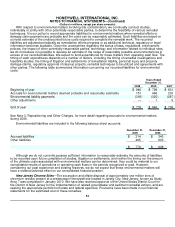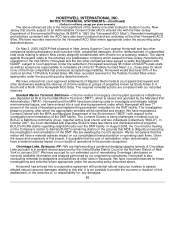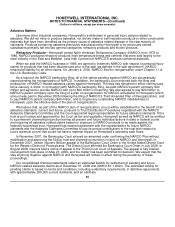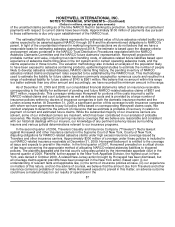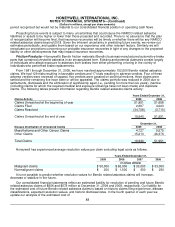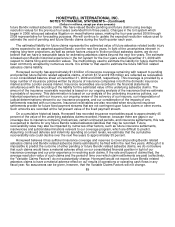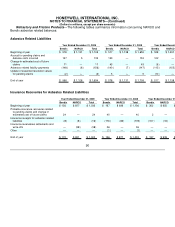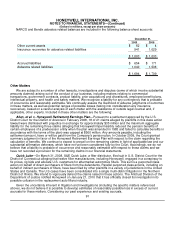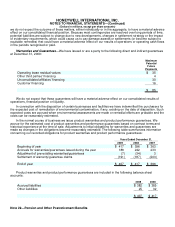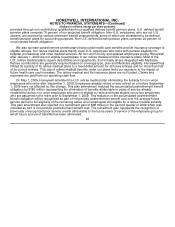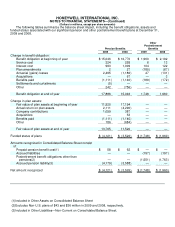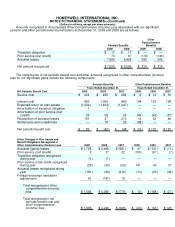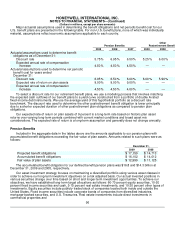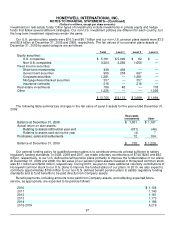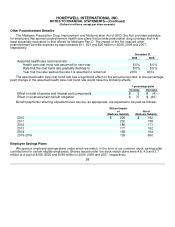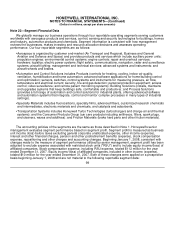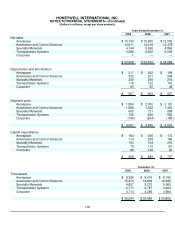Honeywell 2009 Annual Report Download - page 129
Download and view the complete annual report
Please find page 129 of the 2009 Honeywell annual report below. You can navigate through the pages in the report by either clicking on the pages listed below, or by using the keyword search tool below to find specific information within the annual report.
HONEYWELL INTERNATIONAL INC.
NOTES TO FINANCIAL STATEMENTS—(Continued)
(Dollars in millions, except per share amounts)
provided through non-contributory, qualified and non-qualified defined benefit pension plans. U.S. defined benefit
pension plans comprise 76 percent of our projected benefit obligation. Non-U.S. employees, who are not U.S.
citizens, are covered by various retirement benefit arrangements, some of which are considered to be defined
benefit pension plans for accounting purposes. Non-U.S. defined benefit pension plans comprise 24 percent of
our projected benefit obligation.
We also sponsor postretirement benefit plans that provide health care benefits and life insurance coverage to
eligible retirees. Our retiree medical plans mainly cover U.S. employees who retire with pension eligibility for
hospital, professional and other medical services. All non-union hourly and salaried employees joining Honeywell
after January 1, 2000 are not eligible to participate in our retiree medical and life insurance plans. Most of the
U.S. retiree medical plans require deductibles and copayments, and virtually all are integrated with Medicare.
Retiree contributions are generally required based on coverage type, plan and Medicare eligibility. Honeywell has
limited its subsidy of its retiree medical plans to a fixed-dollar amount for all future retirees and for more than half
of its current retirees. This cap of retiree medical benefits under our plans limits our exposure to the impact of
future health care cost increases. The retiree medical and life insurance plans are not funded. Claims and
expenses are paid from our operating cash flow.
On May 1, 2009, Honeywell amended the U.S. retiree medical plan eliminating the subsidy for non-union
employees who retire after September 1, 2009. Employees already retired or who retired on or before September
1, 2009 were not affected by this change. This plan amendment reduced the accumulated postretirement benefit
obligation by $180 million representing the elimination of benefits attributable to years of service already
rendered by active non-union employees who are not eligible to retire and those eligible non-union employees
who are assumed not to retire prior to September 1, 2009. This reduction in the accumulated postretirement
benefit obligation will be recognized as part of net periodic postretirement benefit cost over the average future
service period to full eligibility of the remaining active union employees still eligible for a retiree medical subsidy.
This plan amendment also resulted in a curtailment gain of $98 million in the second quarter of 2009 which was
included as part of net periodic postretirement benefit cost. The curtailment gain represents the recognition of
previously unrecognized prior service credits attributable to the future years of service of the employee group for
which future accrual of benefits has been eliminated.
93


